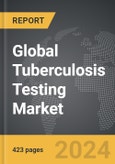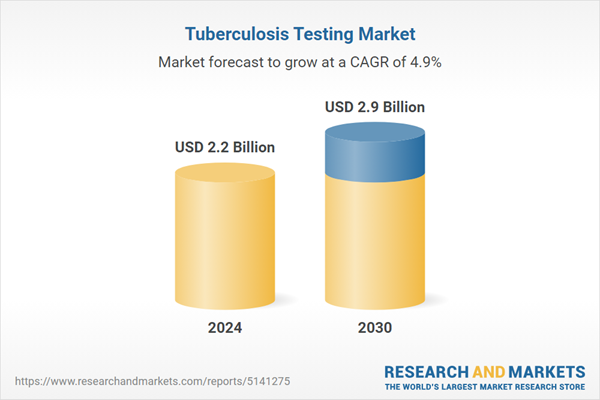Global Tuberculosis Testing Market - Key Trends & Drivers Summarized
Tuberculosis (TB) remains a major global health challenge, and accurate, timely testing is crucial for effective diagnosis and treatment. Tuberculosis testing involves various methods, including skin tests, blood tests, sputum tests, and molecular diagnostics. The traditional Mantoux tuberculin skin test has been widely used, but newer, more accurate tests like the interferon-gamma release assays (IGRAs) and nucleic acid amplification tests (NAATs) have been developed to improve diagnostic accuracy. These advanced tests provide quicker results and are less affected by prior BCG vaccination, which can cause false positives in skin tests.The importance of tuberculosis testing is underscored by the high morbidity and mortality rates associated with the disease, particularly in developing countries. Early and accurate detection is critical to controlling the spread of TB and initiating appropriate treatment. Innovations in molecular diagnostics have significantly enhanced the ability to detect TB, including drug-resistant strains, enabling more targeted and effective treatment regimens. Point-of-care testing devices are also becoming more prevalent, allowing for faster diagnosis and treatment initiation in remote and resource-limited settings.
The growth in the tuberculosis testing market is driven by several factors. The increasing prevalence of TB, particularly in high-burden countries, has heightened the need for effective diagnostic solutions. Technological advancements in molecular diagnostics, such as the development of rapid, automated testing platforms, have improved the speed and accuracy of TB detection. The growing incidence of multidrug-resistant TB (MDR-TB) has also spurred the demand for advanced diagnostic tests that can identify resistance patterns and guide appropriate treatment. Additionally, global health initiatives and funding from organizations such as the WHO and the Global Fund to Fight AIDS, Tuberculosis, and Malaria are supporting the development and deployment of TB testing technologies. The integration of TB testing with broader public health efforts, such as HIV screening, further drives the market by enhancing the reach and impact of diagnostic programs.
Report Scope
The report analyzes the Tuberculosis Testing market, presented in terms of market value (USD). The analysis covers the key segments and geographic regions outlined below.- Segments: Test Type (Culture-Based Tests, Chest X-Ray, Interferon-Gamma Release Assay (IGRA), Mantoux Test (TST), Smear Microscopy, Nucleic Acid Testing (NAT), Serological Tests, Other Test Types); End-Use (Hospitals, Physicians Office, Reference Laboratories, Other End-Uses).
- Geographic Regions/Countries: World; USA; Canada; Japan; China; Europe; France; Germany; Italy; UK; Spain; Russia; Rest of Europe; Asia-Pacific; Australia; India; South Korea; Rest of Asia-Pacific; Latin America; Argentina; Brazil; Mexico; Rest of Latin America; Middle East; Iran; Israel; Saudi Arabia; UAE; Rest of Middle East; Africa.
Key Insights:
- Market Growth: Understand the significant growth trajectory of the Hospitals End-Use segment, which is expected to reach US$1.4 Billion by 2030 with a CAGR of 5.3%. The Physicians Office End-Use segment is also set to grow at 4.4% CAGR over the analysis period.
- Regional Analysis: Gain insights into the U.S. market, valued at $138.6 Million in 2024, and China, forecasted to grow at an impressive 5.6% CAGR to reach $383.4 Million by 2030. Discover growth trends in other key regions, including Japan, Canada, Germany, and the Asia-Pacific.
Why You Should Buy This Report:
- Detailed Market Analysis: Access a thorough analysis of the Global Tuberculosis Testing Market, covering all major geographic regions and market segments.
- Competitive Insights: Get an overview of the competitive landscape, including the market presence of major players across different geographies.
- Future Trends and Drivers: Understand the key trends and drivers shaping the future of the Global Tuberculosis Testing Market.
- Actionable Insights: Benefit from actionable insights that can help you identify new revenue opportunities and make strategic business decisions.
Key Questions Answered:
- How is the Global Tuberculosis Testing Market expected to evolve by 2030?
- What are the main drivers and restraints affecting the market?
- Which market segments will grow the most over the forecast period?
- How will market shares for different regions and segments change by 2030?
- Who are the leading players in the market, and what are their prospects?
Report Features:
- Comprehensive Market Data: Independent analysis of annual sales and market forecasts in US$ Million from 2024 to 2030.
- In-Depth Regional Analysis: Detailed insights into key markets, including the U.S., China, Japan, Canada, Europe, Asia-Pacific, Latin America, Middle East, and Africa.
- Company Profiles: Coverage of players such as Akonni Biosystems, Inc., bioMerieux SA, Creative Diagnostics, CTK Biotech, Inc., DiaSorin SpA and more.
- Complimentary Updates: Receive free report updates for one year to keep you informed of the latest market developments.
Some of the 55 companies featured in this Tuberculosis Testing market report include:
- Akonni Biosystems, Inc.
- bioMerieux SA
- Creative Diagnostics
- CTK Biotech, Inc.
- DiaSorin SpA
- Jiangsu Medomics Medical Technology Co., Ltd.
- NeoGenomics Laboratories, Inc.
- QIAGEN GmbH
- Siemens Healthineers AG
- Takara Bio, Inc.
- Thermo Fisher Scientific, Inc.
- ZeptoMetrix LLC
This edition integrates the latest global trade and economic shifts into comprehensive market analysis. Key updates include:
- Tariff and Trade Impact: Insights into global tariff negotiations across 180+ countries, with analysis of supply chain turbulence, sourcing disruptions, and geographic realignment. Special focus on 2025 as a pivotal year for trade tensions, including updated perspectives on the Trump-era tariffs.
- Adjusted Forecasts and Analytics: Revised global and regional market forecasts through 2030, incorporating tariff effects, economic uncertainty, and structural changes in globalization. Includes historical analysis from 2015 to 2023.
- Strategic Market Dynamics: Evaluation of revised market prospects, regional outlooks, and key economic indicators such as population and urbanization trends.
- Innovation & Technology Trends: Latest developments in product and process innovation, emerging technologies, and key industry drivers shaping the competitive landscape.
- Competitive Intelligence: Updated global market share estimates for 2025, competitive positioning of major players (Strong/Active/Niche/Trivial), and refined focus on leading global brands and core players.
- Expert Insight & Commentary: Strategic analysis from economists, trade experts, and domain specialists to contextualize market shifts and identify emerging opportunities.
Table of Contents
Companies Mentioned (Partial List)
A selection of companies mentioned in this report includes, but is not limited to:
- Akonni Biosystems, Inc.
- bioMerieux SA
- Creative Diagnostics
- CTK Biotech, Inc.
- DiaSorin SpA
- Jiangsu Medomics Medical Technology Co., Ltd.
- NeoGenomics Laboratories, Inc.
- QIAGEN GmbH
- Siemens Healthineers AG
- Takara Bio, Inc.
- Thermo Fisher Scientific, Inc.
- ZeptoMetrix LLC
Table Information
| Report Attribute | Details |
|---|---|
| No. of Pages | 423 |
| Published | December 2025 |
| Forecast Period | 2024 - 2030 |
| Estimated Market Value ( USD | $ 2.2 Billion |
| Forecasted Market Value ( USD | $ 2.9 Billion |
| Compound Annual Growth Rate | 4.9% |
| Regions Covered | Global |









